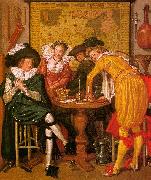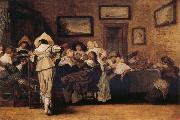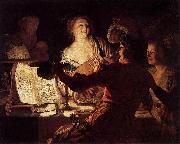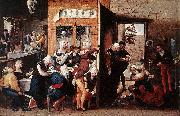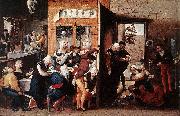Wholesale Oil Painting No Minimum |
|||||||||||
|
|
|||||||||||

|
|||||||||||
|
|
|
||||||||
Willem Buytewech1591-1624 Dutch Willem Buytewech Locations Dutch painter, draughtsman and etcher. Although he was born and died in Rotterdam, stylistically he belongs to the generation of young artists working in Haarlem at the beginning of the 17th century. He was nicknamed Geestige Willem (Dut.: inventive, or witty, Willem) by his contemporaries, and during his short career he made an important and highly personal contribution to the new approach to realism in Dutch art. He was one of the first to paint interiors with merry companies (see CONVERSATION PIECE) and is primarily known for his lively and spontaneous drawings and etchings on a wide range of subjects. |
||||||||
|
|
||||||||
Merry Company
Merry Company Painting ID:: 289 |
1620-22
Szepmuveszeti Muzeum, Budapest 1620-22 Szepmuveszeti Muzeum, Budapest |
|||||||
|
|
||||||||
Dirck HalsDutch 1591-1656 Dirck Hals Galleries Dirck Hals (born at Haarlem, 1591-1656) was a Dutch painter of festivals and ballroom scenes. He was influenced by his elder brother Frans Hals. |
||||||||
|
|
||||||||
|
|
Merry Company
Merry Company Painting ID:: 33678 |
mk86
undated
Oil on panel
45x67.5cm
mk86 undated Oil on panel 45x67.5cm |
||||||
|
|
||||||||
Gerard van Honthorst(November 4, 1592 - April 27, 1656), also known as Gerrit van Honthorst and Gherardo della Notte, was a Dutch painter of Utrecht. He was brought up at the school of Abraham Bloemaert, who exchanged the style of the Franckens for that of the pseudo-Italians at the beginning of the 16th century. Margareta Maria de Roodere and Her Parents by Gerrit van Honthorst (1652) Oil on canvas, 140 x 170 cm. Centraal Museum, UtrechtInfected thus early with a mania which came to be very general in the Netherlands, Honthorst went to Italy in 1616, where he copied the naturalism and eccentricities of Michelangelo da Caravaggio. Home again about 1620, after acquiring a considerable practice in Rome, he set up a school at Utrecht which flourished exceedingly. Together with his colleague Hendrick ter Brugghen, he represented the so-called Dutch Caravaggisti. In 1623 he was president of his gild at Utrecht, where he had married his cousin. He soon became so fashionable that Sir Dudley Carleton, then English envoy at The Hague, recommended his works to the earl of Arundel and Lord Dorchester. In 1626 he received a visit from Rubens, whom he painted as the honest man sought for and found by Diogenes. |
||||||||
|
|
||||||||
|
|
Merry Company
Merry Company Painting ID:: 77369 |
1623
Oil on canvas
125 x 157 cm
cjr 1623 Oil on canvas 125 x 157 cm cjr |
||||||
|
|
||||||||
Jan van Hemessen(c. 1500 - c. 1566) was a Flemish Northern Renaissance painter. He was born in Hemiksem, then called Hemessen or Heymissen. Following studies in Italy, in 1524 he settled in Antwerp. A mannerist, his images focused on human failings such as greed and vanity. Like his daughter, Catarina van Hemessen,he specialised in painted portraits. Jan Sanders van Hemessen was a Flemish Northern Renaissance painter who was part of the mannerist movement. He was born in Hemessen in the Netherlands but settled in Antwerp in 1524 after studying in Italy. Hemessen specialized in scenes of human character flaws such as vanity and greed. His pictures are often religious, while his style helped found the Flemish traditions of genre painting. Hemessen was also a portrait painter, which influenced his daughter to become a Flemish Northern Renaissance painter as well. The Surgeon of 1555 is an oil painting by Jan Sanders Van Hemessen currently in the Museo del Prado in Madrid, Spain. The scene likely represents a stonecutter at a fair. The surgeon, who is clearly happy that his operations have been successful, painstakingly moves his knife towards the stone, which is already visible. Behind him hang stones which have been successfully cut out of the head of other patients as a sign of his skill. Next to the quack stands a man who is wringing his hands in desperation, clearly going to be the next patient under the scalpel. |
||||||||
|
|
||||||||
|
|
Merry Company
Merry Company Painting ID:: 85158 |
Date c. 1540(1540)
Medium Oil on oak panel
Dimensions Height: 29 cm (11.4 in). Width: 45 cm (17.7 in).
cjr Date c. 1540(1540) Medium Oil on oak panel Dimensions Height: 29 cm (11.4 in). Width: 45 cm (17.7 in). cjr |
||||||
|
|
||||||||
Jan van Hemessen(c. 1500 - c. 1566) was a Flemish Northern Renaissance painter. He was born in Hemiksem, then called Hemessen or Heymissen. Following studies in Italy, in 1524 he settled in Antwerp. A mannerist, his images focused on human failings such as greed and vanity. Like his daughter, Catarina van Hemessen,he specialised in painted portraits. Jan Sanders van Hemessen was a Flemish Northern Renaissance painter who was part of the mannerist movement. He was born in Hemessen in the Netherlands but settled in Antwerp in 1524 after studying in Italy. Hemessen specialized in scenes of human character flaws such as vanity and greed. His pictures are often religious, while his style helped found the Flemish traditions of genre painting. Hemessen was also a portrait painter, which influenced his daughter to become a Flemish Northern Renaissance painter as well. The Surgeon of 1555 is an oil painting by Jan Sanders Van Hemessen currently in the Museo del Prado in Madrid, Spain. The scene likely represents a stonecutter at a fair. The surgeon, who is clearly happy that his operations have been successful, painstakingly moves his knife towards the stone, which is already visible. Behind him hang stones which have been successfully cut out of the head of other patients as a sign of his skill. Next to the quack stands a man who is wringing his hands in desperation, clearly going to be the next patient under the scalpel. |
||||||||
|
|
||||||||
|
|
Merry Company
Merry Company Painting ID:: 89483 |
1540(1540)
Medium oil on oak panel
cyf 1540(1540) Medium oil on oak panel cyf |
||||||
|
|
||||||||
|
Jan van Hemessen (c. 1500 - c. 1566) was a Flemish Northern Renaissance painter. He was born in Hemiksem, then called Hemessen or Heymissen. Following studies in Italy, in 1524 he settled in Antwerp. A mannerist, his images focused on human failings such as greed and vanity. Like his daughter, Catarina van Hemessen,he specialised in painted portraits. Jan Sanders van Hemessen was a Flemish Northern Renaissance painter who was part of the mannerist movement. He was born in Hemessen in the Netherlands but settled in Antwerp in 1524 after studying in Italy. Hemessen specialized in scenes of human character flaws such as vanity and greed. His pictures are often religious, while his style helped found the Flemish traditions of genre painting. Hemessen was also a portrait painter, which influenced his daughter to become a Flemish Northern Renaissance painter as well. The Surgeon of 1555 is an oil painting by Jan Sanders Van Hemessen currently in the Museo del Prado in Madrid, Spain. The scene likely represents a stonecutter at a fair. The surgeon, who is clearly happy that his operations have been successful, painstakingly moves his knife towards the stone, which is already visible. Behind him hang stones which have been successfully cut out of the head of other patients as a sign of his skill. Next to the quack stands a man who is wringing his hands in desperation, clearly going to be the next patient under the scalpel. Merry Company 1540(1540) Medium oil on oak panel cyf |
||||||||
|
|
||||||||
|
Prev Next
|
||||||||
|
|
||||||||
|
Related Paintings to Jan van Hemessen :. |
||||||||
|
|
||||||||
|
CONTACT US |
